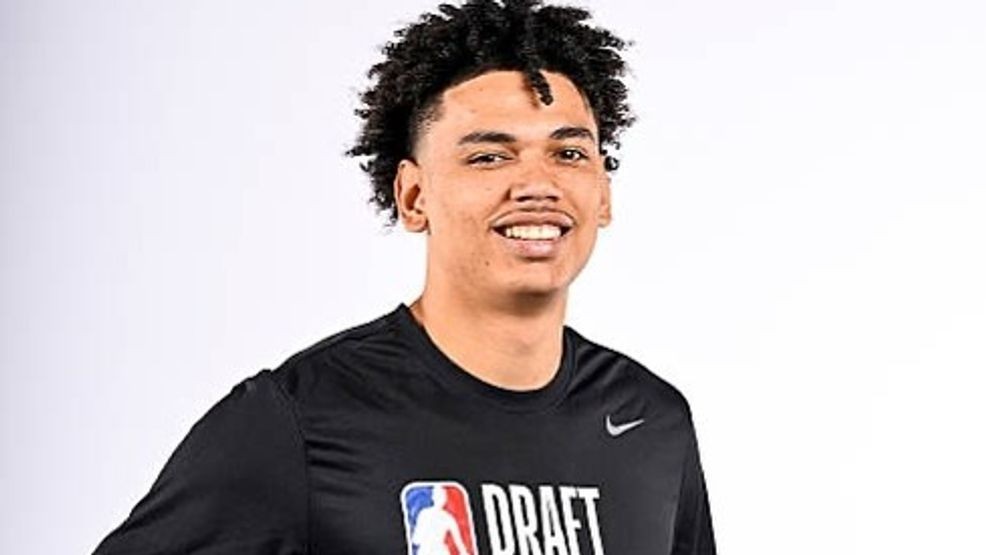Nevada basketball alum Kobe Sanders was one of 75 players invited to the NBA draft combine, giving him an opportunity to show scouts and organizations why he should be selected in next month’s draft. Below are Sanders’ results from the combine.
Anthro measurements
Height (without shoes): 6-feet, 7-inches
Standing reach: 8-feet, 7-inches
Weight: 203.2 pounds
Wingspan: 6-feet, 8.25 inches
Hand length: 8.50 inches
Hand width: 9.25 inches
Sanders was listed by Nevada at 6-foot-9 and 207 pounds (he was listed by Cal Poly the year prior at 6-8 and 205). He measured 6-7 without shoes, which probably puts him at an NBA height of 6-8, which is plenty tall for a wing. He could add some weight to his frame and his wingspan (6-8.25) was one of the smallest compared to his height of anybody at the combine at plus-1.25 inches. But Sanders’ size is a plus for NBA teams.
Strength and agility drills
Lane agility: 10.95 seconds (23rd in field)
Shuttle run: 3.00 seconds (tied for 37th)
Three-quarter sprint: 3.19 seconds (tied for 24th)
Standing vertical leap: 30 inches (tied for 24th)
Max vertical leap: 36 inches (27th)
Sanders was not considered an elite athlete heading into the combine, so his testing numbers were in the expected range. Nevada’s last NBA draft combine participant, Jalen Harris, crushed this area, which helped him get drafted. Sanders’ numbers were neutral as he didn’t have a top-20 mark in any category, which was to be expected and can be compensated to a degree by his size. The smaller twitchy guards are usually going to post the best marks in these categories.
Shooting drills
Off dribble: 23-of-30 (tied for eighth)
Spot up: 15-of-25 (tied for 31st)
3-point star: 14-of-25 (33rd)
3-point side: 16-of-27 (tied for 15th)
Free throw: 10-of-10 (tied for first)
This was another area where Sanders got neutral marks. He was perfect from the free throw line and top 10 in off-dribble mid-range. His 3-point marks were OK. Sanders’ biggest appeal to NBA teams is his size and shooting combination after he shot 34.2 percent from three and 47.8 percent on long twos, the latter of those marks being elite. Sanders was a career 32.9 percent shooter from three during his college career, so he’ll have to prove to teams he can make NBA threes to get drafted.
Scrimmages
Sanders did not play in the two scrimmages he was scheduled to appear in at the combine, due to an ankle injury, his agency told ESPN. Sanders had a good second game at the senior-only Portsmouth Invitational, which might have gotten him an invitation to the draft combine. But that ankle kept him from further making his case to be drafted, a missed opportunity he unfortunately didn’t have much control over.
Others notes
* Former Nevada wing Darrion Williams, who played the last two seasons at Texas Tech, also was at the NBA draft combine and showed his strong all-around game in the scrimmages but shot 1-for-9 and finished with two points in those games. He’s currently in the transfer portal and could stay in college for one more season and cash a final big check before turning pro in 2026.
* Also of Mountain West interest was San Diego State’s Miles Byrd, who drew positive reviews after shooting well in the scrimmages and showing the defensive value that potentially makes him a second-round draft pick. Byrd is just 20 and has two years of college eligibility remaining, so he has a big decision ahead. A return to SDSU would make the Aztecs the clear favorite in the MW next season.
* Another MW player, Nique Clifford, is projected to go 23rd overall to Indiana in ESPN’s post-combine mock draft. Byrd is 43rd overall to the Jazz. And Williams is 47th overall to the Bucks. Sanders is not on the mock draft but is 74th overall on ESPN’s top-100 big board. Next up for these prospects are team workouts. Sanders could get up to a dozen of those before the draft, which starts June 25.

